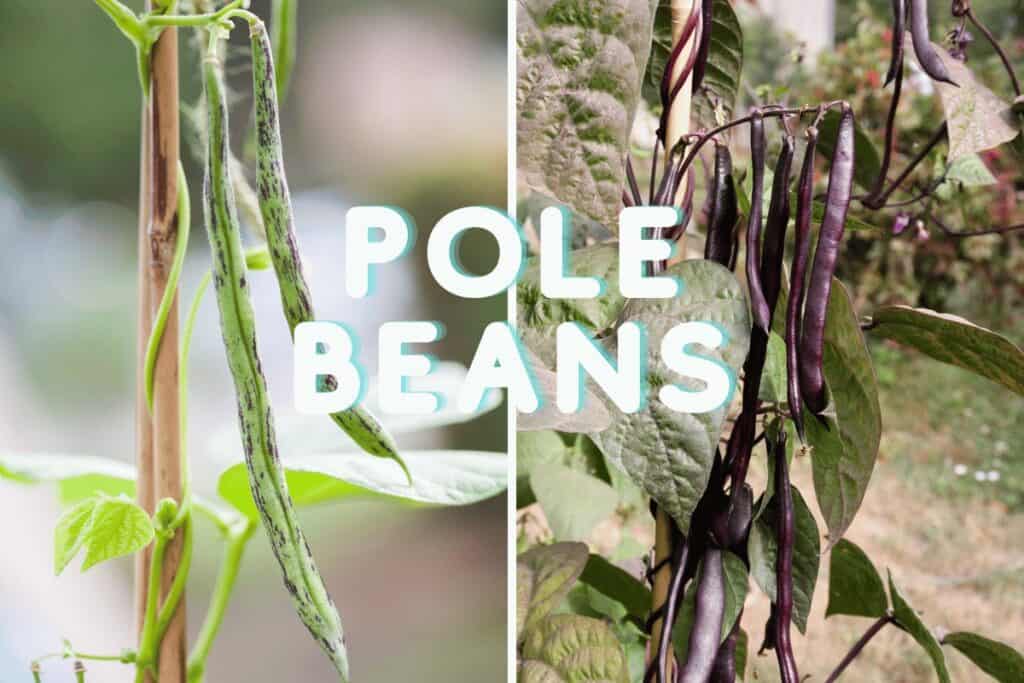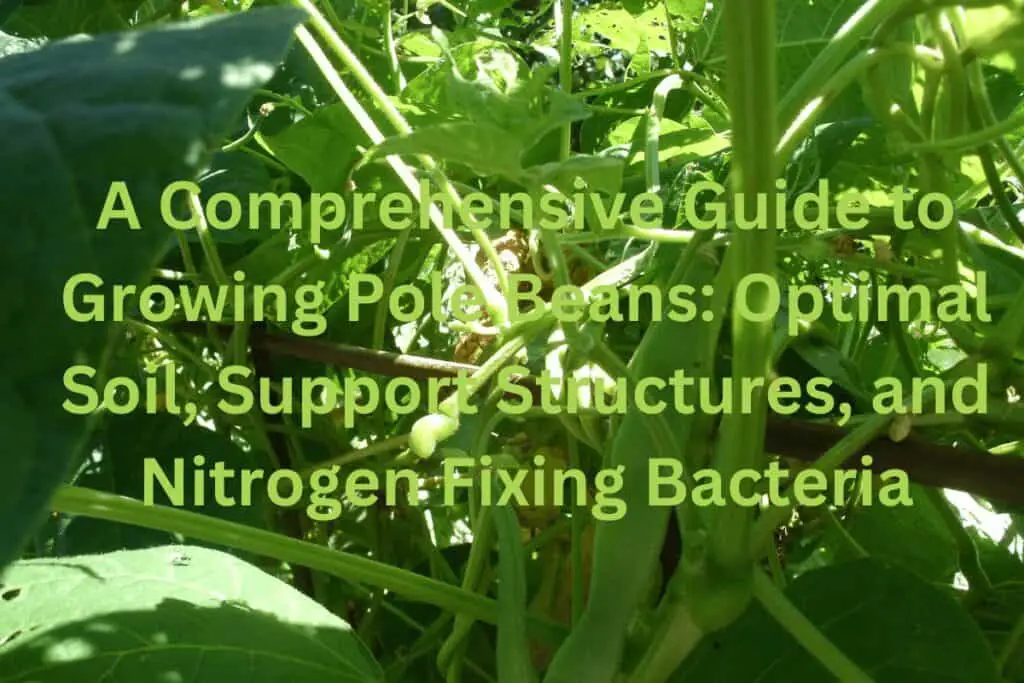Pole beans, also known as climbing beans, are a popular vegetable crop that can be grown in the backyard or the garden. The benefits of pole beans include their high nutritional value, ease of growth, and bountiful harvest.
However, growing pole beans requires some essential steps to ensure optimal growth and yield. This comprehensive guide will provide a step-by-step guide to growing pole beans, covering the essentials of optimal soil, support structures, and nitrogen-fixing bacteria.
Growing pole beans can be a fun and rewarding experience, whether you are a seasoned gardener or just starting out. Pole beans are a great choice for home gardens because they are easy to grow and produce a high yield in a small space.
In this article, we will provide you with a comprehensive guide to growing pole beans, including information about soil conditions, support structures, watering, and planting.
Optimal Soil for Growing Pole Beans

Optimal soil conditions are essential for the growth and development of pole beans. Soil acidity levels, commonly measured using the pH scale, are an essential factor to consider when growing pole beans [1].
Most bean varieties require soil with a pH of 6.5, which is not too acidic or basic. Before planting or amending the soil, ensure you get a soil sample of the garden area.
The soil conditions are a critical factor in growing pole beans. Most bean varieties do well with a soil pH of 6.5, which is not too acidic or basic [1]. Soil testing is usually a free or low-cost service provided by the local Cooperative Extension office.
Amending Your Soil
If your soil pH is not in the optimal range, you can amend it by adding organic matter, such as compost or manure, or by adding lime to increase the pH or sulfur to decrease it.
Be sure to follow the instructions on the product label carefully and allow enough time for the amendments to take effect before planting [1].
Support Structures
Pole beans need a support structure at least 6 feet (2 m.) high, and the vines can grow 5 to 10 feet (1.5-3 m.) long [2]. A trellis or teepee made of bamboo or other sturdy materials is a popular option for supporting pole beans.
You can also use other structures, such as a fence or a wall, as long as they are sturdy enough to support the weight of the vines.
Providing Support
It is important to provide support for your pole beans as they grow. Beans need a little help climbing their support structure, especially when young [2]. You can use soft ties or string to attach the vines to the support structure, being careful not to damage the vines. As the vines grow, they will begin to wrap themselves around the structure, providing additional support.
Proper Watering Technique
The proper watering technique is crucial for developing healthy and uniform plants, reducing root disease issues, and controlling plant growth [3]. Some common symptoms of improper watering include uneven drying, reduced shoot, and root growth, and weak plants with poor shelf life [3].
Pole beans need at least an inch (2.5 cm.) of water per week and should not be allowed to dry out, but also cannot tolerate soggy soils [2]. Consistent moisture is key to the health and productivity of pole beans, especially during dry spells [3].
There are several techniques and tools for proper watering. Premier Tech Horticulture specialist Troy Buechel recommends that plants should be watered deeply, but not too frequently.
Watering deeply helps promote root growth and reduce water waste while watering too frequently can lead to shallow roots and poor plant growth [1].
Mike, a landscaping expert, shares different types of watering tools and techniques and explains which is best for each scenario [2].
It is important to understand the water needs of the plants you are growing and adjust the watering frequency and amount accordingly.
Generally, plants need more water during hot and dry weather, while less water is needed during cooler weather or when the soil is moist [3]. Additionally, it is best to water plants in the morning or late afternoon to minimize water loss from evaporation and reduce the risk of plant diseases [3].
By using the proper watering technique and tools, you can help your plants grow healthy and strong while reducing water waste and cost [3].
Support Structures for Growing Pole Beans
Pole beans require support structures to climb as they grow. A sturdy support structure, at least 6 feet high, is needed as the vines can grow to 5 to 10 feet long [2]. The vines need a little help climbing their support structure, especially when they are young. Therefore, as they grow, it is essential to provide support by tying them loosely to the structure. Providing support also helps prevent soil-borne diseases by keeping the vines off the ground.
Kentucky Blue Pole Bean Seeds

Seeds 40 Count Seed Pouch Heirloom Non-GMO Vegetable Garden(Phaseolus vulgaris)
About this item
- 👨🌾Kentucky Blue Pole Bean seeds for planting can be harvested as soon as sixty days after being sown.
- Kentucky Blue Pole Bean Pods will have a taste very similar to a green bean. Kentucky Blue Pole Beans seed packs are non-GMO and open-pollinated.
- Kentucky Blue Pole Bean seed pack comes in a Resealable/Reusable Gold Zipper Bag that is great for storing excess seeds.
Watering Requirements for Growing Pole Beans
Like all plants, pole beans need water to thrive. They require at least an inch of water per week, and it is crucial to ensure they do not dry out. On the other hand, they cannot tolerate soggy soils, which can lead to root rot [2].
Ensure the soil is moist but not waterlogged. Water the plants early in the day to reduce evaporation and prevent diseases from developing.
Role of Nitrogen Fixing Bacteria in Growing Pole Beans

Pole beans are legumes and require nitrogen in the soil to thrive. One of the easiest ways to ensure that pole beans have enough nitrogen is by inoculating the beans with nitrogen-fixing bacteria before planting.
Inoculation is an optional step, but it can improve the plant’s growth and yield [3]. Nitrogen-fixing bacteria form a symbiotic relationship with pole bean plants and convert atmospheric nitrogen into a form that the plant can use.
FAQs
How often should I fertilize pole beans?
Pole beans do not require regular fertilization as they can fix nitrogen from the atmosphere. However, if the soil is deficient in essential nutrients, adding a balanced fertilizer before planting can improve the plant’s growth.
Can I plant pole beans in a container garden?
Yes, pole beans can be grown in container gardens. However, it is essential to provide a sturdy support structure for the vines to climb.
What are pole beans, and how are they different from bush beans?
Pole beans are a type of bean plant that grows on a vine and requires support to climb. They produce long, slender beans and can reach heights of up to 10 feet. In contrast, bush beans are a more compact plant that grows low to the ground and doesn’t require support.
What’s the best way to prepare the soil for planting pole beans?
The soil should be prepared by loosening it to a depth of 8 to 10 inches and adding organic matter, such as compost or well-rotted manure, to improve the soil’s fertility and texture. Pole beans prefer slightly acidic soil with a pH of 6.0 to 6.8.
What’s the best time of year to plant pole beans, and how long do they take to mature?
Pole beans can be planted in the spring after the last frost or in mid-summer for a fall harvest. They typically take 60-90 days to mature, depending on the variety.
What’s the best way to support pole beans as they grow?
Pole beans need support to climb and grow. The best way to support them is to create a trellis or teepee using bamboo poles or other sturdy supports. Alternatively, you can use a fence, wire mesh, or another support system that the vines can easily wrap around.
How do I care for my pole bean plants during the growing season?
Pole beans require consistent watering, especially during dry spells, and should be fertilized with a balanced fertilizer every 3-4 weeks.
They should also be checked regularly for pests and diseases, and any diseased or damaged leaves or vines should be removed promptly. Harvesting the beans regularly will encourage the plant to produce more.
Conclusion
In conclusion, growing pole beans is a great way to add fresh, healthy produce to your diet, and it’s also an enjoyable and rewarding hobby. By following the steps outlined in this comprehensive guide, you can successfully grow pole beans in your own garden or outdoor space.
From selecting the right location, preparing the soil, and providing proper support to your plants, to regular watering and fertilization, this guide covers all the key steps for a successful harvest. With a little bit of time and effort, you can enjoy a bountiful crop of delicious and nutritious pole beans.
Latest Posts
- What Types of Lettuces Can You Grow?

- How to Plant Onion Seeds for Maximum Germination

- How to Plant Parsnip Seeds for Maximum Germination

- How to Plant Mushroom Seeds for Maximum Germination

- How to Plant Lettuce Seeds for Maximum Germination

- How to Plant Kale Seeds: A Step-by-Step Guide to Maximum Germination Success!





